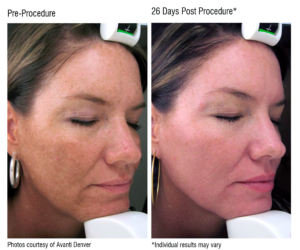Melasma is a skin condition in which dark patches appear on the face (forehead, cheeks, and upper lip). It is due to excessive pigment (melanin) collecting in the skin. The dark patches usually have distinct edges and are symmetrical (similar on both sides of the face). When it occurs during pregnancy, it is often referred to as “chloasma” or the “mask of pregnancy.”

Melasma is very common and occurs in up to six million American women. Although people with melasma may be concerned about its appearance, it is a harmless condition that causes no other health problems.
What Are The Types Of Melasma?
Melasma can be categorized as “epidermal” or “dermal”, or mixed.
Epidermal melasma means the pigment (melanin) is in the more superficial layers of the skin called the epidermis.
Dermal melasma means that the pigment is in the deeper layers of the skin. This distinction is important because epidermal melasma responds more quickly to treatment.
Your doctor may use a “Wood’s Lamp” to determine what type of melasma you have.
What Are The Risk Factors For Melasma?
Although melasma can occur in men, it is most common in women, especially in women of Hispanic or Asian ancestry. If your relatives had melasma, you are also at greater risk of developing melasma.
Women are also at greater risk of developing melasma if they are pregnant, take birth control pills, or take hormone replacement therapy.
Sunlight is essential to the development of melasma. People at risk of developing melasma will notice the patches becoming darker following exposure to sunlight.
Treatments
Treatment results vary greatly among individuals. Your recommended treatment will depend largely on your type of melasma, dermal or epidermal.
Some people with epidermal melasma experience rapid improvement within four to eight weeks of starting treatment, while others may find that improvement takes many months.
It may take time to respond to treatment, so be patient.
Medications for Melasma
The medications prescribed for melasma are called “bleaching” or “depigmenting” agents that cause the skin to stop making melanin.
- Hydroquinone is the most commonly used bleaching agent. It is available in low concentrations over the counter (2%) or as a prescription (4% or stronger). The 2% formulations can be useful once the melasma is under control, but the 4% formulations are usually used to initiate treatment.
- Topical retinoids, such as tretinoin, are a form of vitamin A and may be used to increase the turnover of skin cells, speeding the growth of lighter colored skin.
- Azelaic acid (Azelex®, Finacea®) may help to slow the activity of melanocytes, the cells that make the dark pigment in the skin.
- Tri-Luma® Cream is a prescription-only medication that has been FDA-approved cream for the treatment of melasma. Tri-Luma® combines three ingredients into one topical medication that is used once-a-day. The ingredients include tretinoin, hydroquinone, and fluocinolone acetonide. Fluocinolone acetonide is a topical corticosteroid (“steroid cream”) that reduces irritation and may also help skin lightening.
Procedures for Melasma
Your doctor may discuss the option of various dermatologic procedures that may reduce the appearance of the dark patches, including chemical peels, dermabrasion, or lasers. Fractional lasers have been found to be particularly effective for some types of melasma.
Skin Care Tips
Cosmetic Cover Ups
While waiting for the discoloration to fade, consider using cover-up to reduce the appearance of melasma.
Sun avoidance
Avoiding exposure to sunlight is the most important step in treating melasma and preventing its return. Sunlight is a powerful trigger of pigment formation in people susceptible to melasma. It is strong enough to counteract the effects of medications, even through car windows or on cloudy days.
If you will be exposed to sunlight, take the following measures to prevent the sun from contacting your face:
- Wear a hat with a brim to shade your face.
- Consider using a sun umbrella.
- Avoid reflective surfaces that may cause the light to reflect onto your face.
- Apply sunscreen daily.
When selecting a sunscreen, consider the following:
- Use one with zinc oxide or titanium dioxide. Formulations that are “micronized” may blend better with darker skin.
- Use sunscreen that protects against both UVA and UVB rays.
- Use a sunscreen that is listed as SPF 30 or greater.